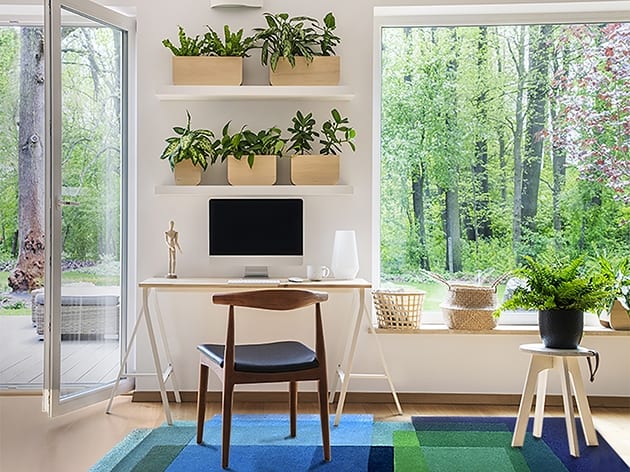 Nature and daylight are critically important to homeworkers, according to this new study|||
Nature and daylight are critically important to homeworkers, according to this new study|||
While agile working and its benefits were part of the norm for most office‐based businesses pre‐Covid, no one expected a pandemic to come along and turn our homes into our permanent workplaces for the foreseeable future.
But our Working from Home survey, launched in April with over 160 participants, revealed that 24 percent noted their home workspace as not appropriate for their needs. And despite a near even split of people working across different rooms within the home, findings showed that less than a quarter (24 percent) were working in a dedicated home office.
Most of us clearly don’t have the luxury of a space or room that we can dedicate to work. Only 27 percent of survey participants reported that space was the top feature that makes them feel good in their home, yet many commented that limited space was incredibly restrictive on their ability to work productively.

Illustration by Félicie Krikler
Post‐lockdown, as businesses re‐evaluate their need for office space and the way they operate, we should be using this opportunity to reflect on how we think about spaces in the home and how we can better accommodate working amongst our home lives.
We are lucky that now, for most of us, working from home only requires enough space to position a small laptop and a decent Wi‐Fi connection. Especially as the old, oversized HP desktop computers and large unwieldy processors that previously necessitated a fixed desk space have become a thing of the past.
To manage the blurring of lines between our down‐time areas and our workspace, it is imperative that when we’re off the clock, we should be able to have our work out of sight and out of mind.
So, we ought to start thinking about space more creatively.
One of my favourite books, Petite Places, looks at small but clever spaces ‐ increasingly relevant as urban apartments are, on the whole, compact and home working begins to scale up.
The book looks at ingenious solutions, whether it’s a dedicated office pod, a desk that can fold out from inside a cupboard, or allocated space for storage to eliminate chaos. Good design can help make working from home both practical and comfortable.

Petite Places by Tessa Pearson, published by Gestalten, 2018
My ideal work zone, as a creative, is enough space to accommodate A3 pads of tracing paper and lots of pens for hand drawings, and the possibility to have a quiet place to make calls away from family noise (or to focus for writing things, like this article!).
In our survey, noise distractions were recorded as coming from a number of sources, whether from a busy household, especially with young children, or construction work from noisy neighbours. By utilising acoustically insulative materials within the home, this problem could be solved ‐ or at least lessened.
Of utmost importance to participants was access to natural daylight and nature, with the Nature Research Journal and Public Health England citing these as crucial to good health and wellbeing.
Consequently, two thirds of participants (66 percent) agreed or strongly agreed that staying indoors for long periods of time has had a negative impact on their mental health.
But it’s key to remember we have undergone the working from home experiment at its most extreme, having taken away our access to nature and choice, which has impacted our mental and physical health. Many have had to deal with further variables, such as home schooling and all working at the same time, which is something you would never have to deal with normally, let alone those who have had to deal with the illness!
So, the future of agile working looks bright post‐pandemic. If there was still any doubt, we now know that the communication tools are there, but thinking about the design of our spaces would certainly help. As architects and designers, it is our role to ensure the homes we design enable ‘agile living’.
While working from home may be a necessity right now, it has a bright future if we reflect on how to best use our home office spaces, says Félicie Krikler, director at Assael Architecture.





















